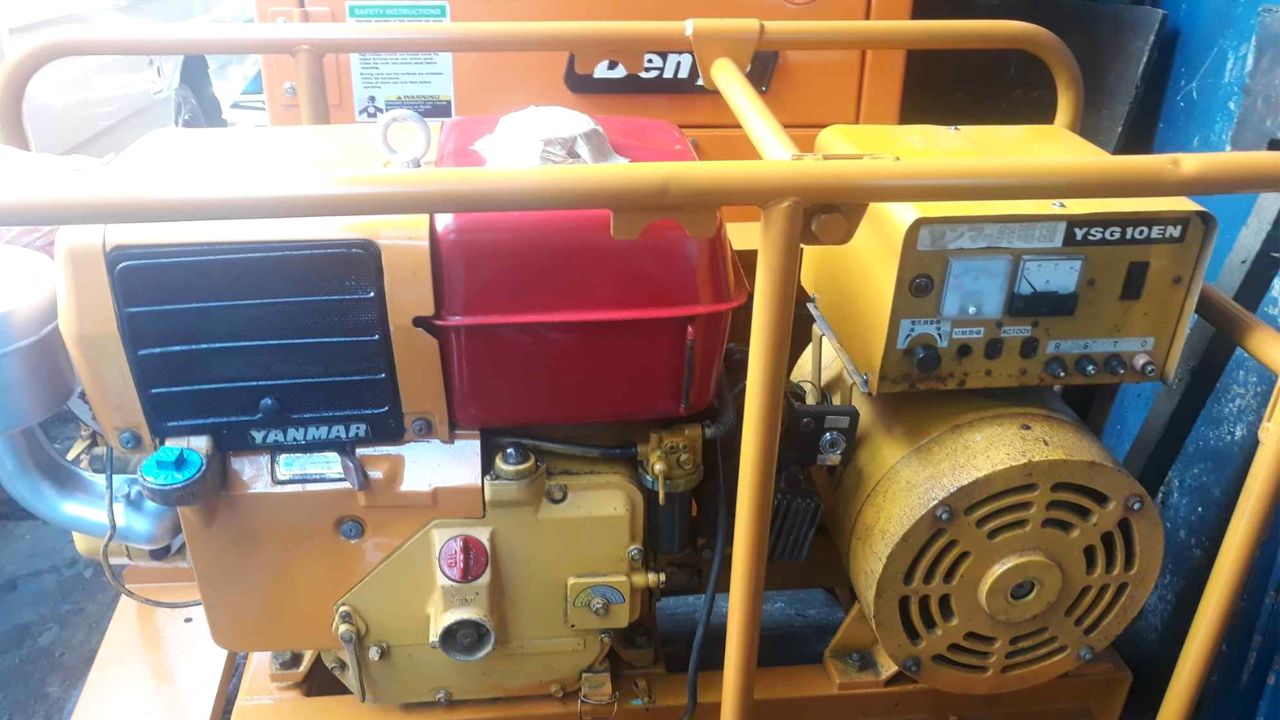How many volts is a generator? This is a question that we often get asked here at the shop. The answer, unfortunately, is not as straightforward as one might hope.
Generators come in a wide range of sizes and capacities, and their voltage output can vary depending on how they’re being used.
That said, most generators will fall somewhere between 100 and 240 volts. The vast majority of household appliances and devices will operate on 120 or 240 volts, so if you’re looking to power your home with a generator, you’ll need one that produces at least that much voltage.
How Many Volts is a Generator? A generator is a machine that converts mechanical energy into electrical energy. The most common type of generator used today is the internal combustion engine, which powers everything from cars to power plants.
But how does a generator work? And how many volts does it produce? The basic principle behind a generator is simple: when a coil of wire spins in a magnetic field, it produces an electric current.
The more coils of wire and the stronger the magnetic field, the more electricity is produced. Most generators used today are what is known as alternating current (AC) generators. That means they produce electricity that alternates between positive and negative voltages dozens or even hundreds of times per second.
The number of voltage “switches” per second is called the frequency, measured in hertz (Hz). In the U.S., the standard household current is 60 Hz; in Europe, it’s 50 Hz. The strength of the voltage produced by an AC generator depends on two things: the number of coils of wire inside it (the more coils, the higher the voltage) and how fast those coils are spinning (the faster they spin, the higher the voltage).
Most small generators used for powering tools or RVs produce around 100 volts AC; large industrial ones can generate several thousand volts. One final note: DC generators also exist, but they’re not nearly as common as AC generators because DC electricity doesn’t travel as far or as easily through power lines as AC does.
- 9500 Running Watts and 12500 Peak Watts (Gasoline); 8500 Running Watts,...
- Features Two GFCI 120V 5–20R Standard Household Receptacle, One Transfer...
- Powered by a Heavy Duty 457cc Westinghouse 4-Stroke OHV Engine Featuring a...
- Plug-and-Play: Comes With a Remote Start Key Fob, 12V Battery Charger, Oil,...
- EFFICIENT CHARGING: Use the adapter included in the package to charge the...
- COMPACT & PORTABLE DESIGN: Super slim size(6.5 x 4.6 x 3.1 inches), the...
- MULTI-OUTPUT: There are 8 output ports could be used at the same time, and...
- BRIGHT LIGHTS: With three levels of brightness, the portable power bank can...
- Keep your family safe with 5600 starting watts and 4500 running watts of...
- Electric start functionality turns the 224cc engine on with the press of a...
- The WEN Watchdog CO Shutdown Sensor helps protect both you and your family...
- 4.3-gallon gas tank provide up to 12.5 hours of half-load run time
How Many Volts is a Generator?
What is the Normal Voltage for Generator?
There is no definitive answer to this question as the voltage for generators can vary depending on several factors, such as the type of generator, the size of the generator, and the specific application for which it is being used. However, most generators typically operate within a range of 120-240 volts.
Do Generators Produce 240 Volts?
Yes, generators can produce 240 volts. The voltage is determined by the number of windings in the generator’s stator, which is the stationary part of the generator. The more windings there are, the higher the voltage that can be generated.
How Many Volts is a Portable Generator?
A portable generator is a great way to have power when you need it, whether you’re camping or dealing with an emergency. But how much power does a portable generator provide? The answer may surprise you – most portable generators provide between 1000 and 2000 watts of power.
That might not sound like much, but it’s enough to run small appliances and even recharge your smartphone. If you need more power than that, you’ll have to look into a larger generator.
Can You Get 220 Volts from a Generator?
Yes, you can get 220 volts from a generator. A generator is an electrical device that converts mechanical energy into electrical energy. The most common type of generator used to produce 220 volts is a petrol or diesel engine-driven alternator.
Generator Output Ac Or Dc
If you’re considering purchasing a generator, you may be wondering if it’s better to get one that produces AC or DC power. Here’s a look at the pros and cons of each type so you can make an informed decision.
AC generators are more common and tend to be less expensive than DC generators.
They’re also easier to maintain because they have fewer parts. However, AC power can’t be stored as easily as DC power, so if you need a backup generator for long-term power outages, DC may be the better option.
DC generators are typically used in applications where AC power can’t be used, such as for charging batteries.
They’re also more efficient than AC generators and can produce higher voltages. However, they’re more expensive and require more maintenance.
Generator Voltage
If the voltage at the terminals of a generator is less than the rated value, the power output will be reduced. If the voltage is too low, the generator may not start. The most common cause of low voltage is a low speed of rotation.
Generator Output Voltage Formula
If you’re a regular reader of this blog, then you know that we often talk about generators. We’ve even written a few posts about the generator output voltage formulas. Today, we’re going to take a more in-depth look at this topic.
As you probably know, generators are used to produce electricity. They work by converting mechanical energy into electrical energy. The output voltage of a generator is determined by the speed at which it is rotating.
The output voltage formula for a generator is: V = E × P ÷ S where: V is the output voltage in volts E is the number of turns in the coil (the “emf” or “electromotive force”)
P is the power (measured in watts) S is the speed (measured in revolutions per minute) Basically, the faster the generator is rotating, the higher the output voltage will be.
Of course, other factors can affect the output voltage as well, such as the number of turns in the coil and the size of the generator’s engine. But speed is one of the most important factors.
3-Phase Generator Voltage Output
If you’re in the market for a 3-phase generator, you’ll want to make sure you understand the voltage output options. The most common voltages for 3-phase generators are 208, 240, and 480 volts. Here’s a breakdown of each option:
208 volt: This is the standard voltage for single-phase residences in the United States. It will work for most applications but isn’t as powerful as the other two options. 240 volt: This is the standard voltage for three-phase residences in the United States.
It’s more powerful than 208 volts and can run more appliances simultaneously. 480 volt: This is the most powerful voltage option and is typically only used for commercial or industrial applications.
How Many Amps Do I Need for a Generator
A generator is a machine that converts mechanical energy into electrical energy. generators are used in everything from small electronic devices to large ships and power plants. the capacity of a generator is usually measured in watts or kilowatts, but sometimes amperage is used instead.
How many amps does my generator need? It depends on the wattage rating of your generator and the voltage you need. Most portable generators have a 120-volt outlet, which can power small appliances like radios and coffee makers.
However, some appliances require more than 120 volts, such as clothes dryers and air conditioners. For these appliances, you’ll need to use a 240-volt outlet, which requires a higher amperage.
The amount of amperage your generator produces should be listed on the nameplate, which is typically located on the control panel.
If you can’t find the nameplate, look in your owner’s manual or contact the manufacturer directly. Once you know how many amps your generator produces, check the wattage rating of your appliance to determine whether it can be powered by your generator.
Generator Calculations Formulas
If you are in the market for a generator, there are several important calculations that you need to be aware of to make sure that you purchase the right one. Here are some key formulas that will help you determine what size and type of generator are best for your needs. 1. Calculate your power requirements: The first step is to calculate the total wattage of all the devices and appliances that you want to run on your generator.
Add up the wattage of each item and then add 20% to that number to account for surge watts. This is the minimum power output that your generator should have to safely run all of your desired devices. 2. Determine how long you need to run your devices: The next step is figuring out how long you need to be able to run your devices on the generator.
This will help you determine how big of a fuel tank you need, as well as how often you’ll need to refuel. To do this, simply divide the total wattage by the number of hours that you want to be able to use your devices (i.e., if your total wattage is 5,000 and you want to be able to use your devices for 10 hours, then 500 watts per hour). 3. Choose between different types of generators: There are two main types of generators-portable and standby.
Portable generators are less expensive but require more maintenance than standby generators. Standby generators are more expensive upfront but can provide peace of mind knowing that they will automatically turn on in case of a power outage (assuming they are properly installed and maintained).
Generator Power Output Calculation
The output of a generator is the power it produces. The capacity of a generator is the amount of power it can produce. The size of a generator is its physical dimensions, usually expressed in terms of length, width, and height.
To calculate the power output of a generator, you need to know its capacity and efficiency. The capacity is measured in watts and the efficiency is measured in percent. To calculate the power output, multiply the capacity by the efficiency.
For example, if a generator has a capacity of 1000 watts and an efficiency of 80%, its power output would be 800 watts.
How to Adjust Generator Voltage
If you have a generator that isn’t providing enough power, you may need to adjust the voltage. Here’s how to do it:
First, locate the voltage regulator on your generator.
It should be near the control panel. Once you’ve found it, use a voltmeter to test the output voltage of your generator.
If the reading is too low, you’ll need to increase the voltage.
To do this, simply turn the voltage regulator knob clockwise. Keep turning until you reach the desired voltage.
If the reading is too high, you’ll need to decrease the voltage.
To do this, turn the voltage regulator knob counterclockwise. Keep turning until you reach the desired voltage.
Conclusion
A generator is a machine that converts mechanical energy into electrical energy. The most common type of generator is an internal combustion engine (ICE) that uses gasoline, diesel, or natural gas to power a rotating alternator. This alternator produces alternating current (AC), which can be used to power lights, appliances, and other devices.
The voltage of a generator depends on the number of turns in its winding and the strength of the magnetic field. Most generators have two windings: a low-voltage winding for starting the engine and a high-voltage winding for producing electricity. The high-voltage winding typically has more turns than the low-voltage winding and is wound with thicker wire to handle the higher voltages.
The output voltage of a generator can be increased by using a step-up transformer. A step-up transformer increases the voltage by changing the ratio of primary to secondary turns in the transformer’s windings. For example, if the primary has 100 turns and the secondary has 200 turns, then the output voltage will be twice as high as the input voltage.





